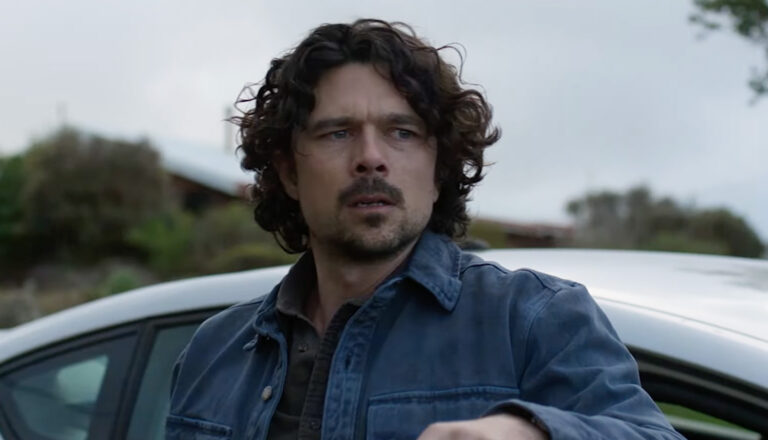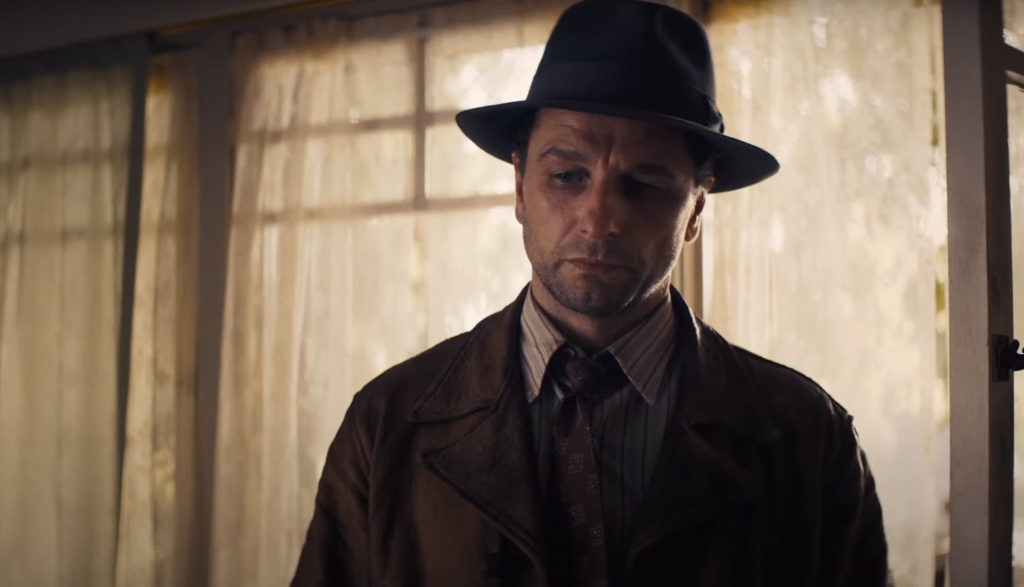
Scrublands
Scrublands’ Martin Scarsden is good at uncovering buried secrets, even when the secrets put his own life—and others’—at risk.

City of Angels? Forget about it.
There’s nothing heavenly about the Los Angeles Perry Mason sees, smells, feels. Nothing angelic about two-bit criminals he chases in and out of the courtroom, nothing holy about the sleaze he sees night after night. The streets of this city are paved with broken glass and broken dreams, the pearly gates locked with a chain of lead.
Take the latest case the rinky-dink detective-turned-lawyer is working now, in 1932. A little baby, Charlie, was swiped from his parents’ house with the kidnappers demanding a $100,000 ransom. Somehow this grocer and his wife managed to raise the dough, but the ’nappers killed the baby anyway—stitching the child’s eyes open so it’d look like he was still alive.
But when well-heeled lawyer E.B. Jonathan asks then-disheveled detective Perry to look at the case, the detective has some questions. One, how did a grocer get a hundred grand? Two, how would the crooks know he could get it? Could the strange church that the grocer (and his well-heeled benefactor) be somehow involved? And why are the police so eager for Perry Mason to move on?
Maybe Los Angeles was once a city of angels, but no more. Perry knows it’s a city of rats now. And he might just catch a few before he closes this case.
Perry Mason, the character, has been around since the early 1930s—though most would know him as a lawyer, not a hard-boiled detective. He specialized in defending hard-luck clients and winning impossible cases, often mixing detective work with a first-rate legal mind. He starred in more than 80 books and short stories, one long-running TV series starring Raymond Burr (not to mention a shorter one in the 1970s), and 30 made-for-TV films.
But despite all that ink and screen time, Perry Mason was far more enigmatic than many of the clients he defended or criminals he caught. While hardly an authoritative source, Wikipedia tells us that, “very little is known about Perry Mason [from the novels]. His family, personal life, background, and education are not depicted, although according to the first chapter of The Case of the Sleepwalker’s Niece (1935), his astrological sign was Leo. Mason has a professional relationship with Paul Drake. Della Street is Mason’s only evident (though not sharply delineated) romantic interest. … Other than those sketchy facts, there is so little physical description of him that the reader is not even sure what he looks like.”
As such, HBO’s new miniseries serves as something of an origin story.
The Perry Mason we meet here grew up on a family farm in southern California—one he struggles to keep afloat. He is a veteran of World War I, but his record is mysteriously tarnished. He’s a divorced dad with a 9-year-old son he barely gets to talk to, and he’s sexually involved with a no-nonsense pilot named Lupe. He’s no lawyer at first. But he becomes one during the course of this first case—a big improvement from his history of buying clean ties from an enterprising mortician and getting drunk in his rundown farmhouse.
But origin story or not, HBO’s version of the lawyer departs from the feel of the character, the original books and the classic show in some significant ways.
If the legend of Perry Mason was built on a combination of Agatha Christie-style whodunit and traditional courtroom drama, HBO’s character is thrust in the grimy, sweaty world of modern film noir. And, to absolutely no one’s surprise, it’s far more problematic than either the novels or the 1950s and ’60s television show that made him famous.
If earlier depictions of Perry Mason effectively locked us out of his personal life, HBO brings us into Perry’s bedroom and locks the door behind us. We see his sexual interludes and drunken fits, we hear him rage and shout and swear (a lot). And as he himself says in the opening episode, the case itself is a “dark tunnel,” occasionally showing us scenes we can’t unsee and wish we could. Oh, and Della Street is no longer a potential romantic partner for good old Perry. She’s in a relationship with another woman.
Meanwhile, our intrepid detective deals with corruption in some of L.A.’s highest corners: The police department has some bad apples in its midst (some of whom appear to be virulently racist), and organized religion (in the form of the powerful radio evangelist Sister Alice) is almost sure to take its own share of knocks. The case, however you look at it, isn’t pretty.
With Matthew Rhys starring as Perry Mason, HBO’s take on the character is well-written and, in its own unpleasant way, engaging. But take Perry’s own warning: This show takes a very dark tunnel to find whatever small light of justice it can.
Emily Dodson, mother of murdered child Charlie Dodson, is literally on trial for her life. She’s being defended by newly minted attorney Perry Mason, but Perry knows he’ll have his work cut out for him if he’s to keep Emily off the gallows.
We see a woman with bare breasts—apparently a prostitute—injected with heroin. (We hear that the prostitute was serving as a wet nurse to the kidnapped Charlie, and it was likely her drug-tainted milk that killed the baby.) We hear a great deal about Emily’s love life during the trial: Her affair with George (who was involved with the real murderers) is unpacked in some detail, with the District Attorney pounding home the point that Emily often had sex with the man at a local hotel. Meanwhile, Perry reveals that he knows the sexual inclinations of his associate Della Street: She’s in a relationship with another woman.
A man is murdered by being held underwater until he expires. In flashback, we see a brutally beaten man shot with a shotgun (blood sprays across someone else’s face), and a bloodied body is dragged across the floor. A doctor stitches up a woman’s forehead, and Emily sports a bruise on her face (the result of a chaotic fracas in the previous episode). We hear about how many people a man killed. There’s a reference to suicide. We see photos of corpses.
[Spoiler Warning] The Radiant Assembly of God—a faith organization that has some critical involvement in the case—is brought down, but members of the congregation (including Emily) go on a revival tour, in part claiming that Charlie was resurrected. (Emily knows the baby is not hers, but either seems to believe that part of Charlie is in the boy … or she’s simply pretending in order to stay connected with the church.) “God wants us to see these miracles,” the female pastor proclaims as Emily sits with her “child.” Perry visits with Sister Alice, the former leader of the church, and the two have a theologically tinged discussion about whether God is really around or not. “You really want to believe in Him, don’t you?” Alice says. “No matter how hard you try, you still hope that He’s there.” There’s a joking reference to a “coven.”
Characters smoke cigarettes and drink alcohol. They also say the f-word 15 times, the s-word twice and let loose with other profanities (“a–,” “d–n” and “pr–k” among them). God’s name is misused twice, once with the word “d–n.” Someone refers to herself as a “wetback.” A bribe is paid.
After catching a couple of major movie stars in a, shall we say, compromising position, Perry turns his attention to a high-profile murder case: the kidnapping and killing of a young boy. But as shocking as the murder itself might’ve been, Perry soon realizes that the culprits may be even more so.
We see the dead child after his parents find his body in a trolley car. The boy’s eyelids have been stitched to his forehead with black thread, apparently to fool the parents into seeing the child from a distance and imagining him still alive. Perry inspects the corpse in the morgue, too: He and the mortician on duty snip and remove a thread from the body, and Perry (who has a son himself) is deeply affected by the sight.
Perry spies on an actor and actress having a sexual encounter. Both are naked: The woman lies on a messy dining table strewn with smeared, half-eaten food, some of which makes its way graphically into the sensual scene. When Perry’s discovered, the man—still fully naked (and fully visible) chases after him down the street.
Perry has his own sexual encounter later with his lover. We see the two graphically and noisily engaged, as well as seeing breast nudity. (The two get dressed shortly thereafter without showing a hint of actual romance between them, and we again see the woman’s breasts.)
Three men are shot and, eventually, die. One expires immediately. A second still lives (blood squirting through a neck artery) before the killer crushes the man’s windpipe with his foot. A third staggers out of the bloody apartment but eventually falls to his death. Someone sticks the heated barrel of a gun onto a man’s exposed chest, burning him. On New Year’s Eve, a policeman says he didn’t have the heart to “crack the skulls” of black revelers, whom he uses a derisive term to describe. Perry (with the apparent permission of the mortician on duty) swipes a clean tie from the effects of a dead man to use for a couple of important meetings. (We see the grey, grinning, apparently strangled corpse of one body, along with the grey feet of other bodies.) The mortician says that one of the victims, a male, was found drowned wearing “panties and a matching bra.”
Perry drunkenly argues with his ex-wife over the phone and smashes the firetruck he bought for his little boy for Christmas (which was returned through the mail). Several people drink out of flasks (during Prohibition), and lots of people smoke, too. Pictures of Sister Alice, the leader of a powerful church, adorn a couple of houses. The dead boy’s mother suggests that she’s being punished by God. Others say how the child was taken up to heaven (albeit by the devices of a demon), and a lawyer talks about God’s providence.
Characters say the f-word about 20 times and the s-word four. We also hear “a–,” “b–tard,” “d–n” “d–k,” “h—” and “p—y.” God’s name is paired with “d–n” three times, and Jesus’ name is abused four times. Perry urinates in his toilet, the bathroom door wide open, as he talks with an associate. (We see Perry from the back.)


Paul Asay has been part of the Plugged In staff since 2007, watching and reviewing roughly 15 quintillion movies and television shows. He’s written for a number of other publications, too, including Time, The Washington Post and Christianity Today. The author of several books, Paul loves to find spirituality in unexpected places, including popular entertainment, and he loves all things superhero. His vices include James Bond films, Mountain Dew and terrible B-grade movies. He’s married, has two children and a neurotic dog, runs marathons on occasion and hopes to someday own his own tuxedo. Feel free to follow him on Twitter @AsayPaul.

Scrublands’ Martin Scarsden is good at uncovering buried secrets, even when the secrets put his own life—and others’—at risk.

Ironheart has your standard Marvel violence, but it also comes with crude language, sexual content and spiritual issues galore.

James and Astrid work through the woes, difficulties and joys of parenting their three children in Children Ruin Everything.

Netflix might not have banked on Squid Game being its most popular show ever. But it sure knew it wanted it bloody.